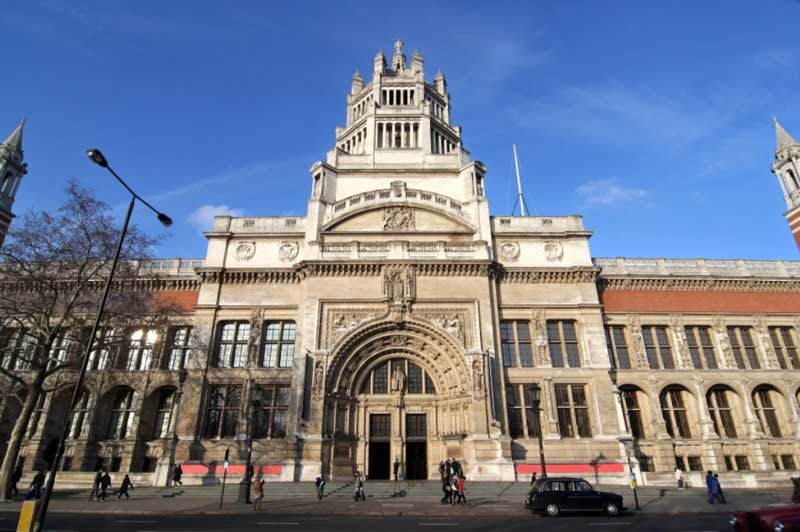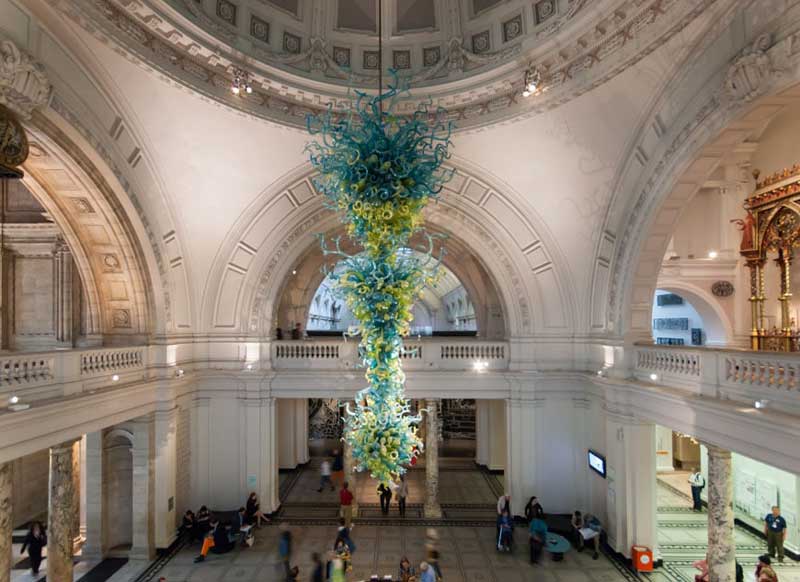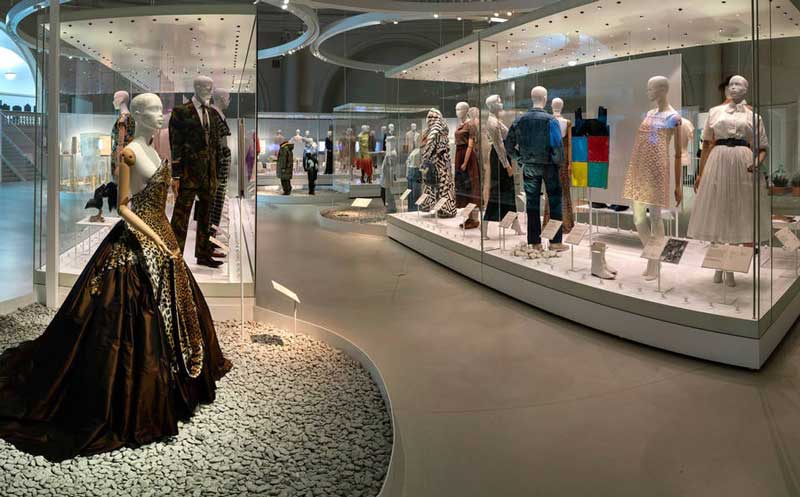
The Victoria and Albert Museum, often popularly mentioned as V&A, and housing a permanent collection of more than 2.27 million items, is generally regarded as the world’s largest museum of decorative arts, designs, and sculpture. The massive museum, equipped with 145 galleries, is located in the Royal Borough of Kensington and Chelsea, in an area known as Albertopolis due to the presence of the Albert Memorial, associated with the memory of Prince Albert, and many other neighbouring major cultural institutions with which he was associated. The adjacent buildings include the Royal Albert Hall, the Natural History Museum, the Science Museum, and the Imperial College. The museum building built in 1857 was initially named the Museum of Manufactures, then renamed South Kensington Museum before officially christened as the Victoria and Albert Museum in 1899.

Founded with the mission to educate designers, manufacturers, and the general public, the Victoria and Albert Museum has its origin in the Great Exhibition of 1851, the world’s first international display of design and manufacturing. The exhibition was held in Crystal Palace, a temporary structure built in Hyde Park from 1 May to 15 October 1851, organized by Prince Albert, husband of Queen Victoria, and Henry Cole, a British civil servant, credited for introducing the world’s first commercial Christmas card in 1843. The grand opening ceremony of the exhibition was presided over by Queen Victoria and Prince Albert, and it was estimated that approximately six million people visited the exhibition before it was closed, which included prominent figures like Charles Darwin, Karl Marx, Charles Dickens, Charlotte Bronte, Lewis Carroll, George Eliot, and Alfred Tennyson.

Following the exhibition, the Crystal Palace was shifted and re-erected in enlarged size at Sydenham Hill in South London in 1854, which was subsequently destroyed by a fire on 30 November 1936. However, at the initiative of Prince Albert, the exhibits were shifted to Marlborough House in the City of Westminster, where the Museum of Manufacturers was opened in May 1852. But within a few months, in the month of September, the museum was moved to the Somerset House, a large Neoclassic building on the south of the Strand in central London, overlooking the River Thames. Subsequently, the new museum in South Kensington was opened by Queen Victoria as South Kensington Museum on 22 June 1857. However, to accommodate the increasingly growing collection, plans for the construction of a new building were developed. The proposed site was occupied by Brompton Park House, which was extended in 1857, and officially opened by Queen Victoria on 20 June 1857.

Finally, the Aston Webb building, located to the left of the main entrance of the South Kensington Museum, was designed by Sir Aston Webb in 1891 as the main building of the Victoria and Albert Museum, and Queen Victoria laid the cornerstone for the new building of the museum on the site on 17 May 1899. During the ceremony, the change of name of the museum from South Kensington Museum to Victoria and Albert Museum was made public. However, while Prince Albert passed away in 1861, Queen Victoria also did not live long enough to see the completion of the new building, which was opened by King Edward VII and Queen Christiana on 26 June 1909.

The main façade of the Victoria and Albert Museum, designed by Sir Aston Webb and constructed between 1899 and 1909, was built with brick and Portland stone and stretches 720 feet (220 m). Although architecturally, much of the details of the façade belong to the Renaissance, medieval influences are also evident. At the same time, the main entrance comprising of a series of shallow arches supported by slender columns and niches with twin doors separated by the pier is Romanesque in form but Classical in detail. Similarly, the tower above the main entrance has an open work crown surmounted by a statue of fame, which is a feature of the late Gothic architecture, but here again, the detail is Classical. Likewise, the main windows of the galleries are mullioned and transomed, divided by vertical or horizontal bars, which are a Gothic feature, but the windows on the top row are interspersed with statues of many of the British artists whose work is displayed in the museum.

Sculptured by Alfred Drury, a statue of Prince Albert is placed within the main arch above the twin entrances, while the statue of Queen Victoria is installed above the frame around the arches and entrance. These façades surround four levels of galleries. The Entrance Hall and Rotunda, the East and West Halls, the areas occupied by the shop and Asian Galleries, and the Costume Gallery, all were designed by Aston Webb. In the interior, marble is used in the entrance hall and flanking staircases. However, the galleries, as originally designed, were white with restrained classical detail and mouldings, which are very much opposed and contrasting to the detailed embellishment of the Victorian galleries. Nevertheless, much of these decorations were subsequently removed in the early 20th century.

At the outbreak of the Second World War in 1939, most of the important items were shifted to different places to be stored in safety, while larger items remained as they were under the protection of bricks and sandbags. During the disturbing period of the Great War, between 1941 and 1944, some of the galleries of the museum were used as a school for children evacuated from Gibraltar, and the South Court was turned into a military canteen, at first serving the Royal Air Force and subsequently the Bomb Damage Repair Squad. Fortunately, the museum survived the Great War only with minor bomb damage. However, the Victorian stained glass on the Ceramics Staircase was blown away during the bombing in the vicinity.

The huge collection of the Victoria and Albert Museum, housing a permanent collection of more than 2.27 million items spanning 5000 years of art, from ancient times to the present, is split into four collection departments, namely Asia; Furniture, Textiles, and Fashion; Sculpture, Metalwork, Ceramic, and Glass; and Word and Image, which are further divided into sixteen display areas, which taken together exceeds 6.5 million items. Its collection of ceramics, glass, textiles, costumes, jewelry, furniture, prints, drawings, and photographs are among the largest and considered the most comprehensive in the world. It also houses the world’s largest collection of post-classical sculptures, and its holding of Italian Renaissance items is considered the largest outside Italy. The departments of Asia in the museum include art from South Asia, China, Japan, Korea, and the Islamic world. While the East Asian collections, particularly the ceramics and metalwork, are among the best in Europe, the Islamic collection is amongst the largest in the Western world. There are invaluable items of Indian art, mainly enriched by the acquisition of materials from the museum of the East India Company after it was closed in 1858. Apart from French furniture, Italian and French arms and armour, German porcelain, and English ceramics and glass, Victoria and Albert Museum also houses the national collection of British watercolours, miniatures, prints, and drawings, along with an outstanding group of works by John Constable.

The Victoria and Albert Museum has undertaken a massive renovation programme since 2001, which included the restoration of the origin Aston Webb interior and hosting the European collection spanning between 1600 and 1815. The new 17th and 18th-century European galleries were, however, opened on 9 December 2015. Interestingly, V&A Dundee was opened on 15 September 2018 as the first Victoria and Albert Museum outside London, and a new branch of the museum in London is on the cards.